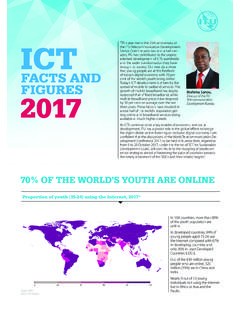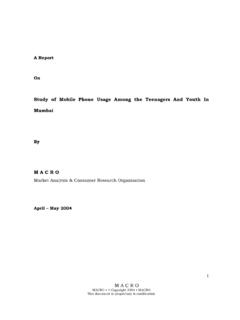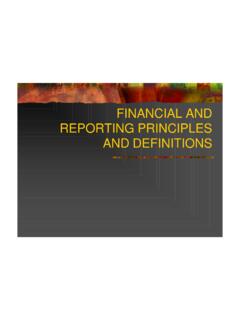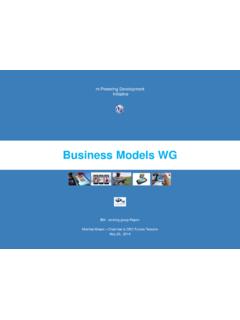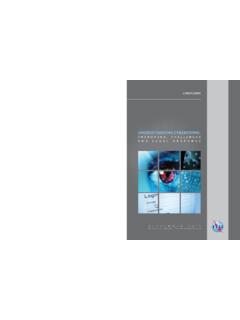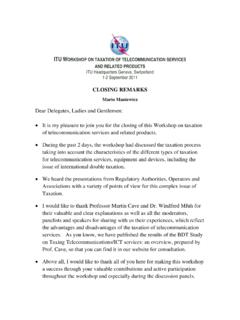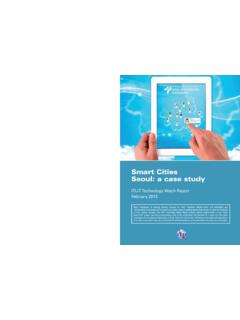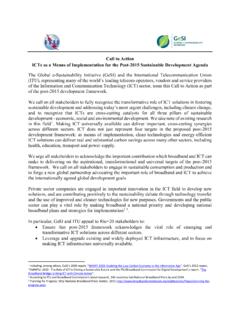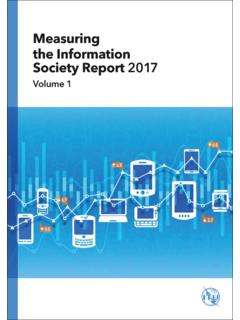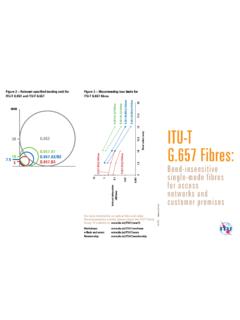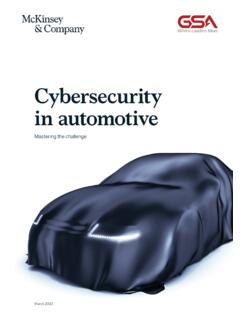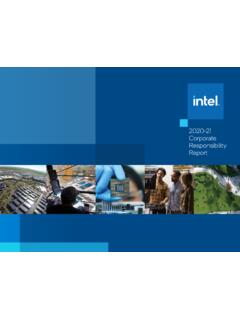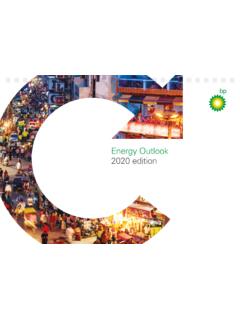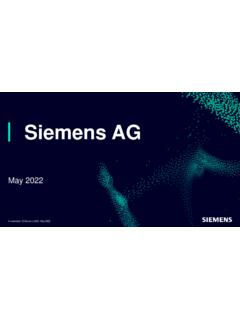Transcription of IMT Vision – Framework and overall objectives of the ...
1 Recommendation ITU-R (09/2015) IMT Vision Framework and overall objectives of the future development of IMT for 2020 and beyond M Series Mobile, radiodetermination, amateur and related satellite services ii Rec. ITU-R Foreword The role of the Radiocommunication Sector is to ensure the rational, equitable, efficient and economical use of the radio-frequency spectrum by all radiocommunication services, including satellite services, and carry out studies without limit of frequency range on the basis of which Recommendations are adopted. The regulatory and policy functions of the Radiocommunication Sector are performed by World and Regional Radiocommunication Conferences and Radiocommunication Assemblies supported by Study Groups. Policy on Intellectual Property Right (IPR) ITU-R policy on IPR is described in the Common Patent Policy for ITU-T/ITU-R/ISO/IEC referenced in Annex 1 of Resolution ITU-R 1.
2 Forms to be used for the submission of patent statements and licensing declarations by patent holders are available from where the Guidelines for Implementation of the Common Patent Policy for ITU-T/ITU-R/ISO/IEC and the ITU-R patent information database can also be found. Series of ITU-R Recommendations (Also available online at ) Series Title BO Satellite delivery BR Recording for production, archival and play-out; film for television BS Broadcasting service (sound) BT Broadcasting service (television) F Fixed service M Mobile, radiodetermination, amateur and related satellite services P Radiowave propagation RA Radio astronomy RS Remote sensing systems S Fixed-satellite service SA Space applications and meteorology SF Frequency sharing and coordination between fixed-satellite and fixed service systems SM Spectrum management SNG Satellite news gathering TF Time signals and frequency standards emissions V Vocabulary and related subjects Note: This ITU-R Recommendation was approved in English under the procedure detailed in Resolution ITU-R 1.
3 Electronic Publication Geneva, 2015 ITU 2015 All rights reserved. No part of this publication may be reproduced, by any means whatsoever, without written permission of ITU. Rec. ITU-R 1 RECOMMENDATION ITU-R IMT Vision Framework and overall objectives of the future development of IMT for 2020 and beyond (2015) Scope This Recommendation defines the Framework and overall objectives of the future development of International Mobile Telecommunications (IMT) for 2020 and beyond in light of the roles that IMT could play to better serve the needs of the networked society, for both developed and developing countries, in the future. In this Recommendation, the Framework of the future development of IMT for 2020 and beyond , including a broad variety of capabilities associated with envisaged usage scenarios, is described in detail. Furthermore, this Recommendation addresses the objectives of the future development of IMT for 2020 and beyond , which includes further enhancement of existing IMT and the development of IMT-2020.
4 It should be noted that this Recommendation is defined considering the development of IMT to date based on Recommendation ITU-R Keywords IMT, IMT-2020 Abbreviations/Glossary ICT Information and Communication Technology IMT International Mobile Telecommunications IoT Internet of Things M2M Machine-to-Machine MIMO Multiple Input Multiple Output QoE Quality of Experience QoS Quality of Service RAT Radio access technology RLAN Radio Local Area Network Related ITU Recommendations, Reports Recommendation ITU-R Framework and overall objectives of the future development of IMT-2000 and systems beyond IMT-2000 Recommendation ITU-R Detailed specifications of the terrestrial radio interfaces of International Mobile Telecommunications Advanced (IMT-Advanced) Report ITU-R Future technology trends of terrestrial IMT systems Report ITU-R IMT Traffic estimates for the years 2020 to 2030 Report ITU-R Technical feasibility of IMT in bands above 6 GHz Report ITU-R Requirements related to technical performance for IMT-Advanced radio interface(s) 2 Rec.
5 ITU-R The ITU Radiocommunication Assembly, considering a) that ITU has contributed to standardization and harmonized use of IMT, which has provided telecommunication services on a global scale; b) that technological advancement and the corresponding user needs will promote innovation and accelerate the delivery of advanced communication applications to consumers; c) that Question ITU-R 229/5 addresses further development of the terrestrial component of IMT and the relevant studies under this Question are in progress within ITU-R; d) that Recommendation ITU-R defines the Framework and overall objectives of the future development of IMT-2000 and systems beyond IMT-2000; e) that for global operation and economies of scale, which are key requirements for the success of mobile telecommunication systems, it is desirable to establish a harmonized timeframe for future development of IMT considering technical, operational and spectrum related aspects; f) that wireless communication applications are expected to expand into new market segments to facilitate the digital economy, smart grid, e-health, intelligent transport systems and traffic control, which would bring requirements beyond what can be addressed in today s IMT application areas; g) that rapid uptake of smartphones, tablets and innovative mobile applications created by users has resulted in a tremendous increase in the volume of mobile data traffic; h) that the number of devices accessing the network are expected to increase due to the emerging applications of Internet of Things (IoT).
6 I) that technologies such as beamforming, massive-Multiple Input Multiple Output (MIMO) are easier to implement in higher frequencies due to short wavelength; j) that wide contiguous bandwidth would enhance data delivery efficiency and ease the complexity of hardware implementation; k) that the cell size is being reduced ( the order of some tens of metres) to provide larger area traffic capacity in dense areas; l) that IMT interworks with other radio systems, recognizing a) that some administrations had deployed IMT-Advanced systems before global deployment due to the rapid increase of data traffic; b) that development of new radio interfaces that support the new capabilities of IMT-2020 is expected along with the enhancement of IMT-2000 and IMT-Advanced systems, noting that pursuant to Article 44 of the ITU Constitution, Member States shall endeavour to apply the latest technical advances as soon as possible, recommends that the Annex should be used as the Framework and the overall objectives for the future development of IMT for 2020 and beyond .
7 Rec. ITU-R 3 Annex TABLE OF CONTENTS Page 1 Introduction .. 3 2 Observation of 4 User and application trends .. 4 Growth in IMT traffic .. 5 Technology trends .. 6 Studies on technical feasibility of IMT between 6 and 100 GHz .. 8 Spectrum implications .. 9 3 Evolution of IMT .. 10 How IMT has developed .. 10 Role of IMT for 2020 and beyond .. 10 4 Usage scenarios for IMT for 2020 and beyond .. 11 5 Capabilities of IMT-2020 .. 12 6 Framework and objectives .. 17 Relationships .. 17 Timelines .. 17 Focus areas for further study .. 19 1 Introduction The socio-technical evolution in the last few decades has been significantly driven by the evolution of mobile communications and has contributed to the economic and social development of both developed and developing countries. Mobile communications has become closely integrated in the daily life of the whole society. It is expected that the socio-technical trends and the evolution of mobile communications systems will remain tightly coupled together and will form a foundation for society in 2020 and beyond .
8 In the future, however, it is foreseen that new demands, such as more traffic volume, many more devices with diverse service requirements, better quality of user experience (QoE) and better affordability by further reducing costs, will require an increasing number of innovative solutions. The objective of this Recommendation is to establish the Vision for IMT for 2020 and beyond , by describing potential user and application trends, growth in traffic, technological trends and spectrum implications, and by providing guidelines on the Framework and the capabilities for IMT for 2020 and beyond . 4 Rec. ITU-R 2 Observation of trends User and application trends Mobile devices play various, continuously evolving roles in everyday life. Future IMT systems should support emerging new use cases, including applications requiring very high data rate communications, a large number of connected devices, and ultra-low latency and high reliability applications.
9 More specific user and application trends are explained in to Supporting very low latency and high reliability human-centric communication People expect the experience of instantaneous connectivity wherein applications need to exhibit flash behaviour without waiting times: a single click and the response is perceived as instantaneous. Flash behaviour will be a key factor for the success of cloud services and virtual reality and augmented reality applications. The low latency and high reliability communication that supports such behaviour thus becomes an enabler for the future development of new applications, in health, safety, office, entertainment, and other sectors. Supporting very low latency and high reliability machine-centric communication The reliability and latency in today s communication systems have been designed with the human user in mind. For future wireless systems, the design of new applications is envisaged based on machine-to-machine (M2M) communication with real-time constraints.
10 Driverless cars, enhanced mobile cloud services, real-time traffic control optimization, emergency and disaster response, smart grid, e-health or efficient industrial communications are examples of where low latency and high reliability can improve quality of life. Supporting high user density Users will expect a satisfactory end-user experience in the presence of a large number of concurrent users, for example in a crowd with a high traffic density per unit area and a large number of handsets and machines/devices per unit area. Examples are audio-visual content to be provided concurrently across an entire cell or infotainment applications in shopping malls, stadiums, open air festivals, or other public events that attract a lot of people. This includes users who use their phone while in unexpected traffic jams, or when travelling in public transportation systems, as well as professionals working in organisations such as police, fire brigades, and ambulances to exploit the public communication networks in crowded environments and machine-centric devices.
